-
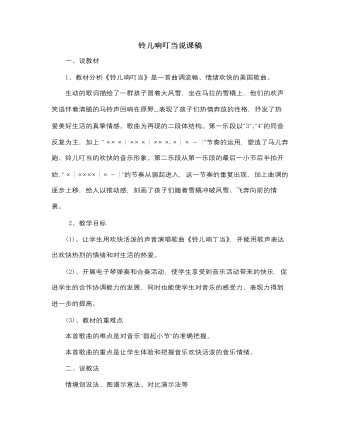
人音版小学音乐五年级下册铃儿响叮当说课稿
结合我们学校的教学条件和我自身会弹琴的优势,我还设计了课堂弹奏活动,激励学生练习好了参加圣诞联欢晚会给大家表演节目。 我把第一段的乐谱进行了简化节奏让学生弹奏,在弹奏基本完成后还设计了学生边唱边弹,并且分组让学生用电子琴自带的的打击乐器进行合奏练习,让学生在学唱的同时更加深入的体会音乐欢快活泼的节奏特点,同时让学生感受合奏的整体的音响效果,培养了学生的动手能力和集体合作能力。 六、总结 本课以歌曲《铃儿响叮当》为主要内容,听、唱、弹等教学环节都围绕他展开,各教学环节的设计易于统一,各项活动的设计均以音乐审美为核心,教学中关注段落的划分,注重引导学生的参与,体验,引导学生积极探索创造学习,展现音乐的节奏之美。
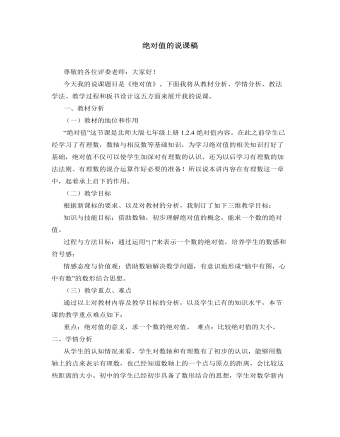
北师大初中数学七年级上册绝对值的说课稿
(三)学以致用,巩固新知为巩固本节的教学重点我再次给出三道问题: 1)绝对值是7的数有几个?各是什么?有没有绝对值是-2的数?2)绝对值是0的数有几个?各是什么? 3)绝对值小于3的整数一共有多少个?先让学生通过小组讨论得出结果,通过以上练习使学生在掌握知识的基础上达到灵活运用,形成一定的能力。(四)总结归纳,知识升华小结时我也将充分发挥学生学习的主动性,发挥教师在教学的启发引导作用,和学生一起合作把本节课所学的内容做一个小结。(五)布置作业,拓展新知布置作业不是目的,目的是使学生能够更好地掌握并运用本节课的内容。所以我会布置这样一个作业:请学生回家在父母的帮助下,找出南方和北方各三个城市的温度,并比较这些温度的大小,并写出每个温度的绝对值进行比较
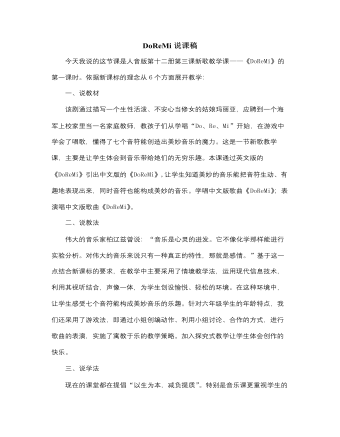
人音版小学音乐六年级下册DoReMi说课稿
1.通过欣赏《DO RE Mi》的影片,调动学生的积极性,增强学生学习新歌的兴趣。2.了解电影。任何一首歌曲都有着不一样的故事,通过文字简介,能够帮助学生深入歌曲的学习,升华表演的情绪。然后通过聆听歌曲《DO RE MI》,师范唱,生听唱,师指导唱的形式来帮助学生继续领略音乐的魅力。7.音乐游戏。不仅将学生分成七个小组跟琴演唱,还让学生根据伴奏完成歌曲接龙,充分体现了学生在课堂中的主体性。8.拓展开发。通过了解柯尔文手势,电影的背景资料和歌曲《孤独的牧羊人》的欣赏,提高学生的能力。第二环节既是这节课的重点,也是难点,通过引导学生运用手势音阶和肢体语言来表演歌曲《DoReMi》,又通过小组合作的方式突破难点。最后小结,简单地总结了同学们的表演让所有人感受到音乐带给我们的无穷乐趣,七个音乐字母构成了美妙的音乐,最后在美妙的音乐中结束了这节课!
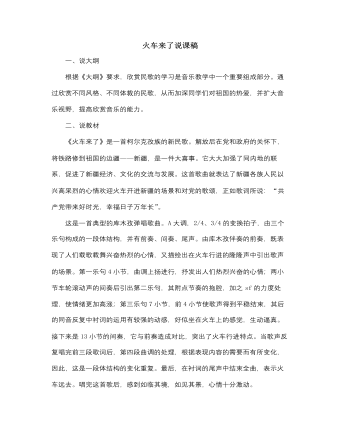
人音版小学音乐六年级下册火车来了说课稿
1、视觉图象法:少数民族的风土人情对我们汉族的孩子来说不那么了解。为了使他们更直接地了解到新疆柯尔克孜族人们的生活习惯,我运用电脑软件制作了一些柯尔克孜族的风情画面,给学生视听结合,避免枯燥的说教形式,使本来抽象的 内容变得具体形象化。2、对比欣赏法:在了解这个民族的风土人情时,我运用画面表格形式将新疆几个民族的人物作对比,从而使学生更清楚的了解这个民族的风土人情、歌曲特点。在教学中我还运用了创设情景、兴趣引入法、感性到理性等方法 。音乐家修海林认为“音乐审美必须要求体验到音乐的意境”,在这一课,我充分运用了多媒体教学手段,尽量让学生体验到音乐的意境,从屏幕上看到新疆的风土人情关系,听到新疆民歌不同的风格特点。
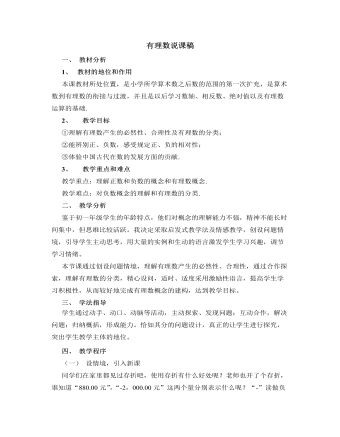
北师大初中数学七年级上册有理数说课稿
1、 教材的地位和作用本课教材所处位置,是小学所学算术数之后数的范围的第一次扩充,是算术数到有理数的衔接与过渡,并且是以后学习数轴、相反数、绝对值以及有理数运算的基础.2、 教学目标①理解有理数产生的必然性、合理性及有理数的分类;②能辨别正、负数,感受规定正、负的相对性;③体验中国古代在数的发展方面的贡献.3、 教学重点和难点教学重点:理解正数和负数的概念和有理数概念.教学难点:对负数概念的理解和有理数的分类.二、 教学分析鉴于初一年级学生的年龄特点,他们对概念的理解能力不强,精神不能长时间集中,但思维比较活跃。我决定采取启发式教学法及情感教学,创设问题情境,引导学生主动思考,用大量的实例和生动的语言激发学生学习兴趣,调节学习情绪。
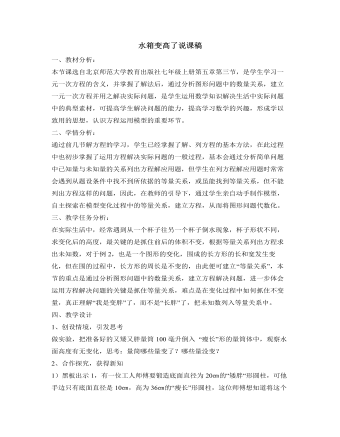
北师大初中数学七年级上册水箱变高了说课稿
一、教材分析:本节课选自北京师范大学教育出版社七年级上册第五章第三节,是学生学习一元一次方程的含义,并掌握了解法后,通过分析图形问题中的数量关系,建立一元一次方程并用之解决实际问题,是学生运用数学知识解决生活中实际问题中的典型素材,可提高学生解决问题的能力,提高学习数学的兴趣,形成学以致用的思想,认识方程运用模型的重要环节。二、学情分析:通过前几节解方程的学习,学生已经掌握了解、列方程的基本方法,在此过程中也初步掌握了运用方程解决实际问题的一般过程,基本会通过分析简单问题中已知量与未知量的关系列出方程解应用题,但学生在列方程解应用题时常常会遇到从题设条件中找不到所依据的等量关系,或虽能找到等量关系,但不能列出方程这样的问题,因此,在教师的引导下,通过学生亲自动手制作模型,自主探索在模型变化过程中的等量关系,建立方程,从而将图形问题代数化。
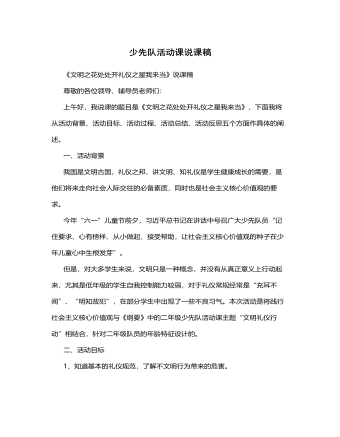
文明之花处处开,礼仪之星我来当说课稿(1)
四、活动总结及反思本次活动,让学生变身“小小侦查员”,调动他们观察发现的积极性,认识到生活中哪些行为是不文明的。运用“新闻直播间”这一新颖的形式,学生在认真聆听讨论之余,知道小小的不文明行为也会造成严重后果。继而通过“情绪体验岛”,引导孩子们在情绪不好的时候,学会自我调整情绪,及时避免不文明行为。最后及时表彰,鼓励其他队员以他们为榜样,使活动主题得以升华。在这一系列充满童趣,层层深入的活动中,同学们表现出了很高的积极性,平时的一言一行都有意识地按文明礼仪的要求做,班风也有了进一步提高。在充分肯定成绩的同时,我们也认识到,不仅要常常开展校园文明礼仪活动,还要开展家庭文明礼仪活动及社会文明礼仪活动,让文明礼仪之花不仅在学校开放,还要开放到家庭、开放到社会,营造出一片人人都讲文明知礼仪的氛围。

文明之花处处开,礼仪之星我来当说课稿(2)
本次活动,让学生变身“小小侦查员”,调动他们观察发现的积极性,认识到生活中哪些行为是不文明的。运用“新闻直播间”这一新颖的形式,学生在认真聆听讨论之余,知道小小的不文明行为也会造成严重后果。继而通过“情绪体验岛”,引导孩子们在情绪不好的时候,学会自我调整情绪,及时避免不文明行为。最后及时表彰,鼓励其他队员以他们为榜样,使活动主题得以升华。在这一系列充满童趣,层层深入的活动中,同学们表现出了很高的积极性,平时的一言一行都有意识地按文明礼仪的要求做,班风也有了进一步提高。在充分肯定成绩的同时,我们也认识到,不仅要常常开展校园文明礼仪活动,还要开展家庭文明礼仪活动及社会文明礼仪活动,让文明礼仪之花不仅在学校开放,还要开放到家庭、开放到社会,营造出一片人人都讲文明知礼仪的氛围。
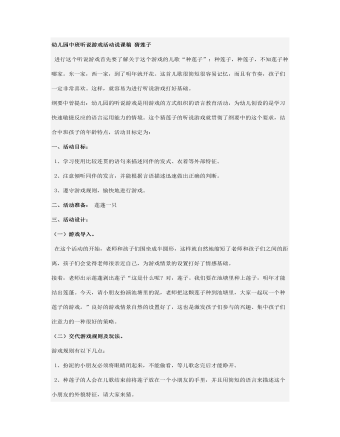
幼儿园中班听说游戏活动说课稿 猜莲子
规则讲完后,孩子们围坐成半圆形,眼睛闭上,手背在后面手掌向上,这样就可以接住老师递过来的莲子。大家开始念游戏儿歌“种莲子”:种莲子,种莲子,不知莲子种哪家。东一家,西一家,到了明年就开花。老师边说儿歌边从每个孩子身后走过,并且把莲子悄悄放入一个孩子手中。最后走到中央,描述这个孩子的特征,如“我把莲子种在一个短头发的女孩手里,她穿着黄衣服、蓝裤子和黑皮鞋”,请孩子们都来猜,猜对了,有莲子的小朋友就要到前面来说“我就是穿黄衣服、蓝裤子和黑皮鞋的短头发小女孩”,然后游戏继续。在大家一起念“种莲子”儿歌的时候,老师要注意纠正个别不正确的发音,鼓励孩子们声音宏亮的念儿歌,提醒孩子种莲子和拿到莲子以后都要注意保密,为孩子们自主游戏做好铺垫。这一步非常重要。为了保证孩子在下一步按规则玩游戏,在孩子感知理解游戏规则的基础上,老师根据孩子掌握程度可以带领着多玩几遍这个游戏。
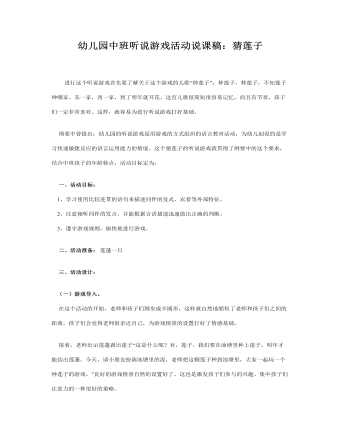
幼儿园中班听说游戏活动说课稿:猜莲子
一、活动目标: 1、学习使用比较连贯的语句来描述同伴的发式、衣着等外部特征。 2、注意倾听同伴的发言,并能根据言语描述迅速做出正确的判断。 3、遵守游戏规则,愉快地进行游戏。 二、活动准备: 莲蓬一只 三、活动设计: (一)游戏导入。 在这个活动的开始,老师和孩子们围坐成半圆形,这样就自然地缩短了老师和孩子们之间的距离,孩子们会觉得老师很亲近自己,为游戏情景的设置打好了情感基础。 接着,老师出示莲蓬剥出莲子“这是什么呢?对,莲子。我们要在池塘里种上莲子,明年才能结出莲蓬。今天,请小朋友扮演池塘里的泥,老师把这颗莲子种到池塘里,大家一起玩一个种莲子的游戏。”良好的游戏情景自然的设置好了,这也是激发孩子们参与的兴趣、集中孩子们注意力的一种很好的策略。
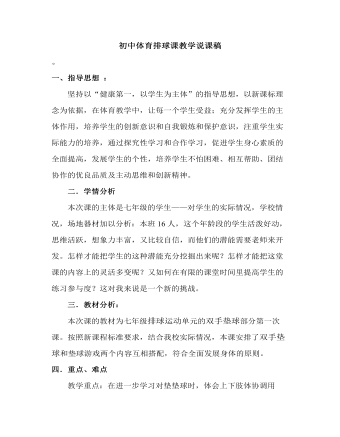
初中体育课教学说课稿
二.学情分析本次课的主体是七年级的学生——对学生的实际情况,学校情况,场地器材加以分析:本班16人,这个年龄段的学生活泼好动,思维活跃,想象力丰富,又比较自信,而他们的潜能需要老师来开发。怎样才能把学生的这种潜能充分挖掘出来呢?怎样才能把这堂课的内容上的灵活多变呢?又如何在有限的课堂时间里提高学生的练习参与度?这对我来说是一个新的挑战。
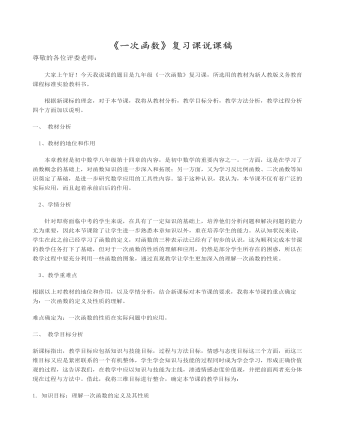
《一次函数》复习课说课稿
1、教材的地位和作用本章教材是初中数学八年级第十四章的内容,是初中数学的重要内容之一。一方面,这是在学习了函数概念的基础上,对函数知识的进一步深入和拓展;另一方面,又为学习反比例函数、二次函数等知识奠定了基础,是进一步研究数学应用的工具性内容。鉴于这种认识,我认为,本节课不仅有着广泛的实际应用,而且起着承前启后的作用。 2、学情分析针对即将面临中考的学生来说,在具有了一定知识的基础上,培养他们分析问题和解决问题的能力尤为重要,因此本节课除了让学生进一步熟悉本章知识以外,重在培养学生的能力。从认知状况来说,学生在此之前已经学习了函数的定义,对函数的三种表示法已经有了初步的认识,这为顺利完成本节课的教学任务打下了基础,但对于一次函数的性质的理解和应用,仍然是部分学生所存在的困惑,所以在教学过程中要充分利用一些函数的图象,通过直观教学让学生更加深入的理解一次函数的性质。
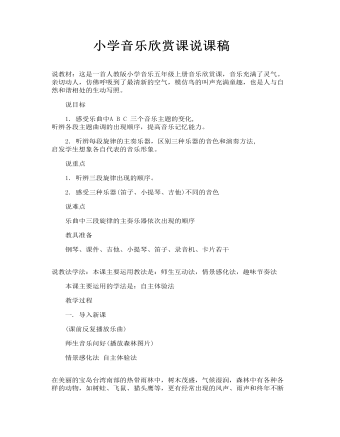
小学音乐欣赏课说课稿
1. 感受乐曲中A B C 三个音乐主题的变化, 听辨各段主题曲调的出现顺序,提高音乐记忆能力。 2. 听辨每段旋律的主奏乐器,区别三种乐器的音色和演奏方法, 启发学生想象各自代表的音乐形象。 说重点 1. 听辨三段旋律出现的顺序。 2. 感受三种乐器(笛子、小提琴、吉他)不同的音色 说难点 乐曲中三段旋律的主奏乐器依次出现的顺序 教具准备 钢琴、课件、吉他、小提琴、笛子、录音机、卡片若干 说教法学法:本课主要运用教法是:师生互动法,情景感化法,趣味节奏法 本课主要运用的学法是:自主体验法

再见了亲人课文说课稿
1、以情激情,介绍背景。教学伊始,我借助录像片段,再现情景,"1950年10月19日,中国人民志愿军开赴朝鲜战场,与朝鲜人民军并肩作战,朝夕相处了8年,结下了深厚的情谊。战争最终以正义和良知取得了胜利。1958年,最后一批志愿军离朝回国,中朝两国人民依依惜别。"学生如亲临现场,初悟离别之情,这样既为理解课文作了情感铺垫,同时揭示了课题。 2、以境激情,撞击情感。 本课紧紧抓住"再见了,亲人"这一抒发情感的主线进行情境的创设,再现两国人民话别的场景、离别的场面,升华学生的情感。 3、 以读激情,读中悟法。 在指导朗读时我引导学生走进人物内心,想象当时的场景,同时在朗读中体会反问句、感叹句在表情达意方面的作用。 我根据这篇课文情感饱满、段落相似的特点,先引导学生初感文本,把握情感基调;再让学生说说触动自己情感之弦的语句和事例;然后以读为本,自悟自得。 围绕着文章的题眼,我精心抽取了"再见了,亲人"这条深情而厚重的丝线,拨动学生的心弦,设计了"讲亲人、诵亲人、别亲人"的大写意、"叠加式"结构。
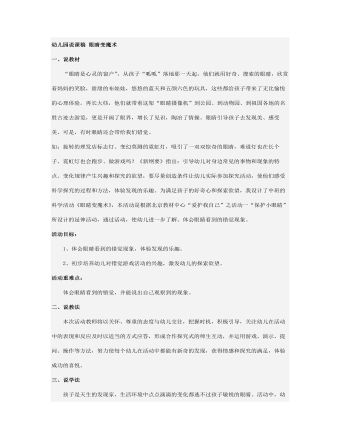
幼儿园说课稿 眼睛变魔术
“眼睛是心灵的窗户”,从孩子“呱呱”落地那一天起,他们就用好奇、搜索的眼睛,欣赏着妈妈的笑脸,甜甜的布娃娃,悠悠的蓝天和五颜六色的玩具,这些都给孩子带来了无比愉悦的心理体验。再长大些,他们就带着这架“眼睛摄像机”到公园、到动物园、到祖国各地的名胜古迹去游览,更是开阔了眼界,增长了见识,陶冶了情操。眼睛引导孩子去发现美、感受美。可是,有时眼睛还会带给我们错觉。如:旋转的理发店标志灯、变幻莫测的霓虹灯,吸引了一双双惊奇的眼睛,难道灯也在长个子、霓虹灯也会跑步、做游戏吗?《新纲要》指出:引导幼儿对身边常见的事物和现象的特点、变化规律产生兴趣和探究的欲望,要尽量创造条件让幼儿实际参加探究活动,使他们感受科学探究的过程和方法,体验发现的乐趣。为满足孩子的好奇心和探索欲望,我设计了中班的科学活动《眼睛变魔术》,本活动是根据北京教材中心“爱护我自己”之活动一“保护小眼睛”所设计的延伸活动,通过活动,使幼儿进一步了解、体会眼睛看到的错觉现象。
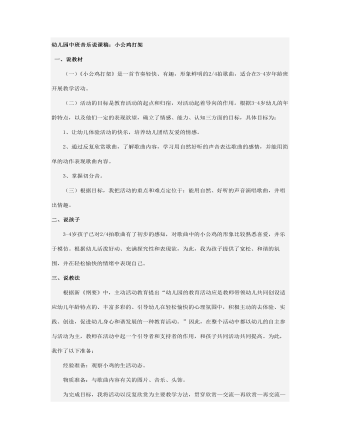
幼儿园中班音乐说课稿
第一部分:律动导入法。老师带领幼儿在音乐伴奏下,表演律动进入活动室,同时用语言、动作提示幼儿随意坐下,为活动开展创设了宽松自由的环境,把孩子引入音乐的氛围环境中。 第二部分:感知法。反复欣赏歌曲,了解歌曲的节拍、旋律特点和风格,进而理解记忆歌曲内容。在这一环节中根据幼儿年龄小、注意力难以集中等特点,运用多种欣赏手段和方法,如:听音乐、师弹音乐、师清唱歌曲、看录象等,并加以多媒体多种辅助教学手段,引导幼儿欣赏,使幼儿在积极主动的姿态中参与活动。 第三部分:表现法。采用集体、小组、个别等教学方法,鼓励幼儿大胆学唱、演唱歌曲,注意难点部分,同时在这一环节中鼓励幼儿尝试用动作表现歌曲,既增加了情趣,又能使幼儿顺利迁移已有经验,这会使幼儿感受到活动给他们带来的成功感缓和满足感。我在整个教育活动中,注意孩子活动过程和参与表演活动的情感。
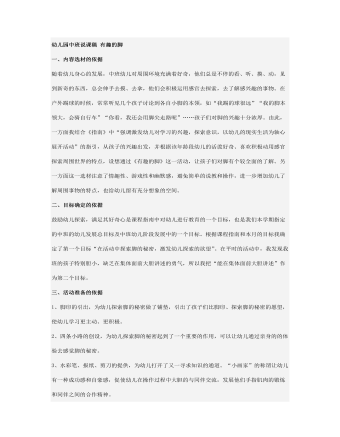
幼儿园中班说课稿 有趣的脚
随着幼儿身心的发展,中班幼儿对周围环境充满着好奇,他们总是不停的看、听、摸、动,见到新奇的东西,总会伸手去摸、去拿,他们会积极运用感官去探索,去了解感兴趣的事物。在户外踢球的时候,常常听见几个孩子讨论到各自小脚的本领,如“我踢的球很远”“我的脚本领大,会骑自行车”“你看,我还会用脚尖走路呢”……孩子们对脚的兴趣十分浓厚。由此,一方面我结合《指南》中“强调激发幼儿对学习的兴趣,探索意识,以幼儿的现实生活为轴心展开活动”的指引,从孩子的兴趣出发,并根据该年龄段幼儿的活泼好奇、喜欢积极动用感官探索周围世界的特点,设想通过《有趣的脚》这一活动,让孩子们对脚有个较全面的了解。另一方面这一选材注意了情趣性、游戏性和幽默感,避免简单的说教和操作,进一步增加幼儿了解周围事物的特点,也给幼儿留有充分想象的空间。
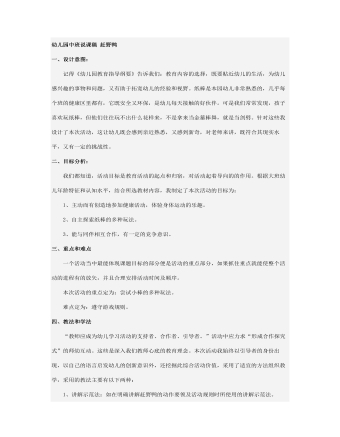
幼儿园中班说课稿 赶野鸭
“教师应成为幼儿学习活动的支持者、合作者、引导者。”活动中应力求“形成合作探究式”的师幼互动。这些是深入我们教师心底的教育理念。本次活动我始终以引导者的身份出现,以自己的语言启发幼儿的创新意识外,还挖掘此综合活动价值,采用了适宜的方法组织教学,采用的教法主要有以下两种: 1、讲解示范法:如在明确讲解赶野鸭的动作要领及活动规则时所使用的讲解示范法。 2、语言提示和具体帮助法:如在幼儿初次尝试赶野鸭时,我运用简单明了、和富有针对性的语言来指导和提示幼儿正确活动,并直接具体的帮助,进行个别指导,做到面向全体。 以幼儿为主体,创造条件让幼儿参加创造活动,不仅提高了认识,锻炼了能力,更升华了情感,本次活动幼儿采用的学法有: 1、游戏法:游戏活动是孩子最重要的学习形式,《纲要》也重申“幼儿园教育应尊重幼儿身心发展规律和学习特点,以游戏为基本活动。”游戏是激发引导幼儿参与活动的重要手段,符合幼儿身心发展特点,满足幼儿身心需要。游戏过程能激发幼儿一直以积极、轻松、愉快、自觉的心情参与活动。因此,整个活动我让游戏贯穿教学过程始终。
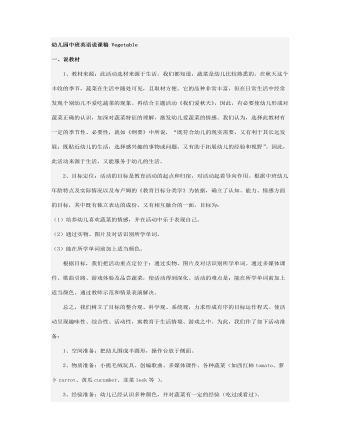
幼儿园中班英语说课稿 Vegetable
教材来源:此活动选材来源于生活。我们都知道,蔬菜是幼儿比较熟悉的。在秋天这个丰收的季节,蔬菜在生活中随处可见,且取材方便。它的品种非常丰富,但在日常生活中经常发现个别幼儿不爱吃蔬菜的现象。再结合主题活动《我们爱秋天》,因此,有必要使幼儿形成对蔬菜正确的认识,加深对蔬菜特征的理解,激发幼儿爱蔬菜的情感。我们认为,选择此教材有一定的季节性、必要性,就如《纲要》中所说,“既符合幼儿的现实需要,又有利于其长远发展;既贴近幼儿的生活,选择感兴趣的事物或问题,又有助于拓展幼儿的经验和视野”。因此,此活动来源于生活,又能服务于幼儿的生活。
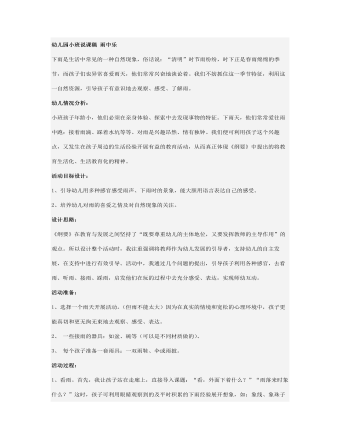
幼儿园小班说课稿 雨中乐
听雨。“雨落下时有什么声音呢?让我们仔细听一听!”孩子对声音是比较敏感的,根据已有经验,他们会很快作出回答“滴答、滴答”教师这时便可启发孩子仔细倾听分辨下大雨和小雨时有不同的声音,雨落在不同的地方会发出不同的声音。如:大雨是哗啦拉、下小雨是淅沥里;雨落在窗户上是叮叮当当、落在树叶上是沙沙沙沙的等等。这样就从不同的角度让孩子有意识地去倾听,发展了孩子的听觉,也不致于使答案是唯一的,而是丰富多彩的、形象生动的。接雨。“让我们用手去接一下雨,会有什么感觉?”幼儿会不假思索地回答“湿湿的、凉凉的”。同时,教师可质疑:“雨接在手里会很快掉到地上,谁有好办法不让雨跑掉吗?”这时,孩子就会去找各种接雨的器具尝试,在肯定孩子成功的同时又可结合着让孩子倾听雨落在不同材质的器具上又有不同的声音。



